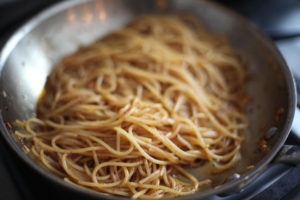 It rarely gets the attention it deserves, but food’s texture is just as important as its flavor. Bubble tea, fried tortilla chips and salsa, panna cotta, Greek salad and a perfect egg omelet are all dependent on this neglected quality.
It rarely gets the attention it deserves, but food’s texture is just as important as its flavor. Bubble tea, fried tortilla chips and salsa, panna cotta, Greek salad and a perfect egg omelet are all dependent on this neglected quality.
If you’ve ever pondered why takeout and leftovers are never as good as food served fresh from the kitchen, texture is the culprit. Without texture, everything we eat may as well be homogenized in a blender. Does that sound appetizing?
Let’s talk about a few ways textural variance adds to the pleasure of your eating experiences, none of which are related to flavor.
Texture is the reason expensive spaghetti tastes better than cheap spaghetti.
Have you ever wondered why the cheapest box of spaghetti is around $1 and other brands sell for $5 or $8? They have exactly the same ingredients: semolina and water. So what gives?
Nothing is more exemplary of the phrase “time is money” than the world of dried, boxed pasta. Dried pasta, or “pastasciutta,” is often extruded from dies. The cheapest brands use Teflon in their dies, which enables them to push more dough through the die faster and produce more pasta in less time.
If you closely examine low-cost pastas, you’ll notice that they are almost shiny and incredibly smooth ― that’s the work of the Teflon die. To save even more time and produce large quantities of pasta, mass manufacturers then quickly dry the pasta, sometimes for only a few hours, before boxing it and shipping it.
The result is a textural disaster. The smooth pasta never fully marries to the sauce, and the quick dry time requires a quicker cook time, which in turn minimizes the window of perfectly cooked, toothsome al dente noodles to just a few seconds long. Further, even if you are lucky to nail the “al dente,” the pasta will slowly wilt in the sauce. And don’t even think about eating it the next day. You’ll find pasta that’s swollen to twice the size it was the day before, melting like baby food when bitten. Read more